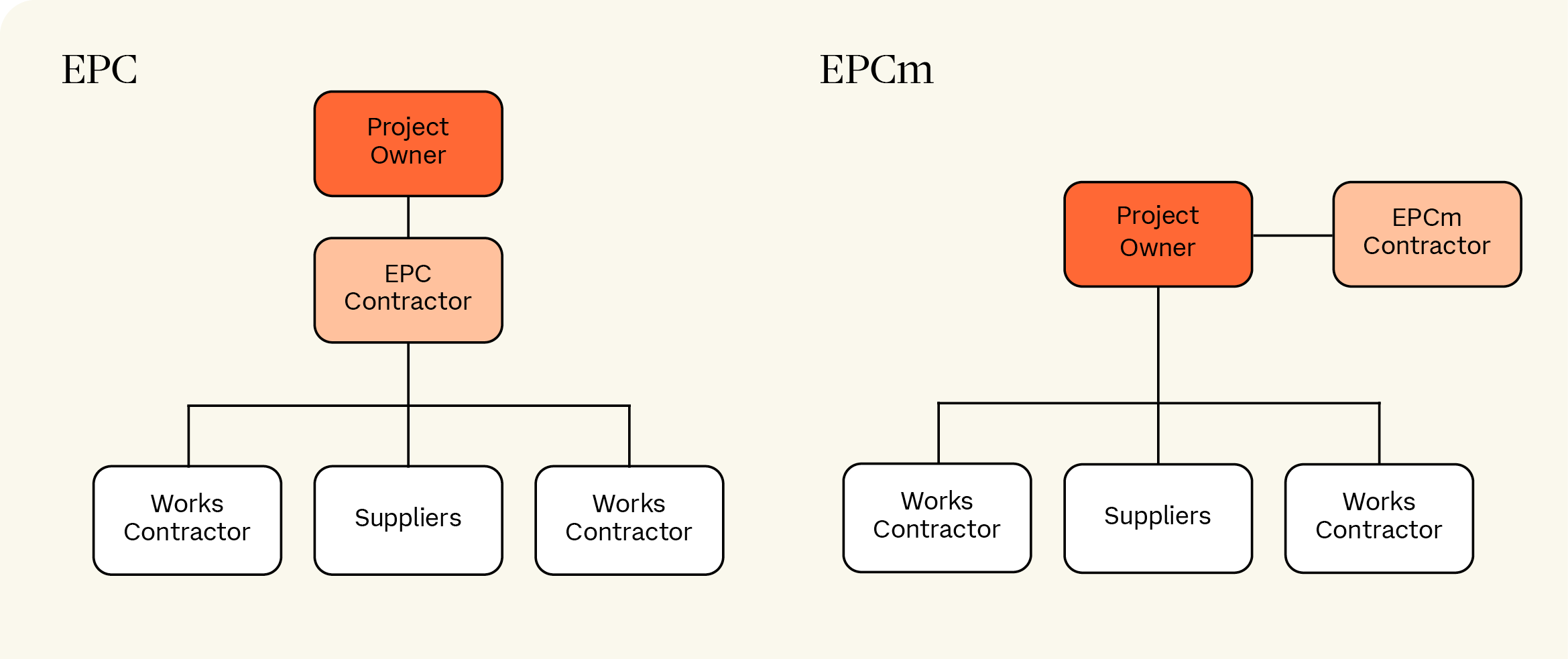International arbitration in 2025
The shift from EPC to EPCM: a recipe for more complex arbitrations?
By Erin Miller Rankin, Matei Purice and Robert Colvin
In brief
As EPCM contract structures gain popularity in global projects, related disputes will become increasingly complex. Key areas of contention will likely include costs recovery and delay provisions, as well as difficulties posed by a more complex allocation of liability inherent in EPCM structures.
The global construction industry faces rising material costs, increasing project complexity from untested energy transition technologies, supply chain disruption and a persistent shortage of skilled labor. These challenges have cooled contractors’ risk appetite and prompted project owners to rethink their strategies for project delivery.
Contractors and owners alike are moving away from the traditional lump sum Engineering, Procurement and Construction (EPC) model in favour of EPCM (or Engineering, Procurement and Construction Management). This shift is driven by EPCM’s distinct risk profile for contractors and its perceived lower costs for project owners. The introduction of IChemE’s “Blue Book” in 2023, the first standard form EPCM contract, underscores this trend. While it remains the only standard form EPCM contract to date, FIDIC is expected to release its own version.
Title
Explainer: EPC v. EPCM
EPC contracts, sometimes referred to as “turnkey” contracts, have long been prevalent in privately funded major projects and publicly funded infrastructure developments. EPC contractors are tasked with delivering a completed asset to the project owner, meeting guaranteed performance standards by a fixed date and cost.
Under an EPC contract, the contractor assumes responsibility for all project elements – Engineering, Procurement, and Construction – along with the associated completion and performance risks. Typically, the project owner (or employer) is responsible for the specification of the facility, providing the site, making payments, and addressing delays it causes to the contractor. The contractor assumes responsibility for all other aspects, subject to a specified liability cap.
In contrast, EPCM contracts are (at their core) not construction contracts; they are services agreements where the EPCM contractor typically takes responsibility for project design, manages procurement of contractors and suppliers, and coordinates their work through to completion. Unlike the EPC model, where the contractor instructs and has contractual recourse to subcontractors and suppliers, the EPCM contractor is not party to the various works or supply contracts. Instead, these agreements are entered into directly by the owner. EPCM contractors do not assume turnkey risk or act as the single point of responsibility. The owner assumes greater completion and financial risk if the project exceeds budget or is delivered late. Under an EPCM structure, liability for the works will be allocated throughout the various work packages to distinct contractors/suppliers; while design, management, and coordination risks rest with the EPCM contractor.
EPCM contracts are increasingly adopted in industries and/or for projects where EPC contractors are unwilling to assume significant risks or where owners seek greater control over project delivery – sometimes at a premium. Historically common in mining and oil & gas, EPCM contracts are now increasingly applied to a broader range of infrastructure and industrial projects.

EPCM structures may initially seem cost-effective for project owners, but cost savings often diminish during execution as owners encounter (i) greater in-house costs for contract management and coordination; (ii) potentially uncapped fees from the EPCM contractor; (iii) the cost of resolving programme delays; and (iv) the possible costs associated with managing multiple, concurrent disputes with the various counterparties. The risk of escalating costs increases when owners lack sufficient in-house resources or systems to manage on-site outcomes and coordinate multiple counterparties – each with varying levels of experience and capability.
We are seeing an increasing number of complex construction arbitrations arising out of EPCM structures.
Multi-party disputes: challenges in EPCM arbitrations
A key complexity in EPCM-related disputes, particularly arbitrations, lies in the number of potential parties involved.
In a typical EPC delay claim, experts analyze the causes of delay and their impact on the critical path. In contrast, EPCM structures introduce additional complexity due to the involvement of multiple contractors and works packages across different project components. In an EPCM structure, owners must first investigate the causes of delays to determine which contractors or suppliers – if any – bear responsibility. In some cases, responsibility may be shared among multiple parties. Owners must also evaluate potential recourse under the various contracts with counterparties, noting that each agreement may include differing and inconsistent risk allocation provisions.
Delays or performance breaches involving multiple counterparties – such as defects at the interface between works packages – can result in concurrent, overlapping disputes.
For example, the IchemE’s Blue Book limits the EPCM contractor’s liability to that which is reasonable for the EPCM contractor to pay, having regard to the contractual responsibility that other project participants might bear for the loss. This framework is likely to raise complex questions of allocation of responsibility and increase the risk of inconsistent outcomes in a multi-party or multi-dispute scenario. We anticipate disputes arising over the interpretation of these provisions particularly where the governing law does not robustly address net contribution liability allocations or apportionment approaches.
The Blue Book specifies a multi-tiered dispute resolution mechanism for disputes only between the owner and EPCM contractor, involving negotiation, optional mediation, and arbitration. However, it lacks joinder or consolidation provisions, posing challenges when liability is shared among multiple parties. In major projects with multiple works contracts, overlapping disputes often arise. The Blue Book recommends including express provisions for third parties to join arbitrations between the owner and EPCM contractor and for consolidating proceedings. To avoid procedural conflicts, all project parties should align their dispute resolution provisions in respective EPCM and works contracts or establish an overarching dispute resolution umbrella agreement.
We expect to see an increase in:
- concurrent arbitrations: owners initiating simultaneous proceedings against the EPCM contractor and works contractors or suppliers, raising the risk of conflicting awards;
-
multi-party arbitrations: increased use of joinder or consolidation of proceedings, resulting in more complex multi-party disputes; and
-
liability disputes: arbitrations about the apportionment of liability for costs, often arising from unclear risk allocation across multi-party suites of contracts.
![]() To pre-empt the risk of concurrent arbitrations, parties should consider adopting arbitral rules with robust consolidation and joinder provisions or including bespoke terms during contract negotiations.
To pre-empt the risk of concurrent arbitrations, parties should consider adopting arbitral rules with robust consolidation and joinder provisions or including bespoke terms during contract negotiations. ![]()
Matei Purice
Counsel
Risk allocation and incentives
EPCM (and indeed any costs plus structure) shifts much of the costs risk away from the contractor onto the project owner.
Project owners face the dual challenge of (a) ensuring EPCM contractors are incentivized to control costs and minimize delays, and (b) auditing the EPCM contract to verify that time charges are reasonable, proportionate, and necessary.
![]() Project owners must take steps from the outset to ensure that their EPCM arrangements adequately allocate and ‘flow down’ risk in the face of the challenges posed by its multi-party contracting structure and cost recovery issues.
Project owners must take steps from the outset to ensure that their EPCM arrangements adequately allocate and ‘flow down’ risk in the face of the challenges posed by its multi-party contracting structure and cost recovery issues. ![]()
Erin Miller Rankin
Partner
Cost recovery disputes often arise when owners argue that EPCM contractors should bear the risk for works contractors’ failures, or when EPCM contractors seek compensation for inefficient time use or rework. Recent key decisions in EPC cases may have significant implications for the scope and method of cost recovery in EPCM disputes. (See CBI Constructors Pty Ltd. And Kentz Pty Ltd. V. Chevron Australia Pty Ltd., Judgment of the Supreme Court of Western Australia [2021] WASC 323, 28 September 2021; and Refinería de Cartagena S.A.S. v. Chicago Bridge & Iron Company NV, CB&I UK Limited and CB&I Colombiana SA, ICC Case No. 21747/RD/MK/PDP, Final Award, 2 June 2023).
Looking ahead
In EPCM contract structures:
-
all parties should ensure contract documents, including technical specifications, adequately clarify the parameters of the interfacing works packages;
-
ensure the dispute resolution mechanisms across the project contract suite talk to each other and/or have all parties agree to a dispute resolution umbrella agreement; and
-
adopt arbitral rules with clear and well-worn consolidation and joinder provisions.
Our team has the relevant expertise to help businesses navigate this emerging area. Please contact us if you would like to explore this topic further in the context of your project or potential project.
- Introduction
- 1. AI in international arbitration: a fast-evolving landscape
- 2. Geopolitical shifts: new political agendas driving investment treaty claims
- 3. Russian disputes and anti-suit injunctions: arbitration and state courts - allies, adversaries, or both?
- 4. Investor-state mediation: a bridge over troubled waters?
- 5. Human rights and social issues in investment treaty arbitration: a growing trend
- 6. Arbitration as a tool for private capital disputes
- 7. Arbitration of space disputes: time for take-off
- 8. Game-changing sports disputes: a new normal
- 9. Privilege in arbitration – should one set of rules apply?
- 10. The shift from EPC to EPCM: a recipe for more complex arbitrations?
- 11. The internationalization of arbitration in Brazil: a rising trend
- 12. Shifting sands: the Middle East’s evolution into an arbitration hub


